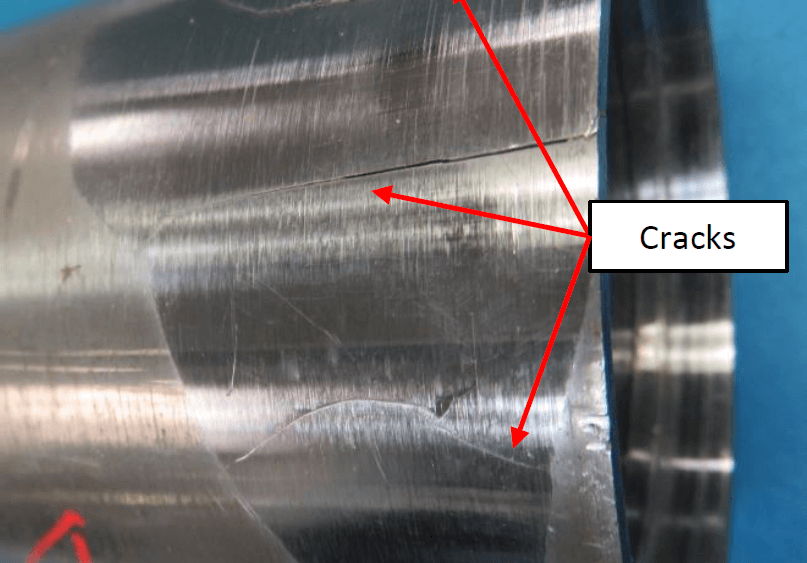SCOPE
It is well recognized by wireline coring diamond-drill operators, drill rod suppliers, borehole surveyors and survey equipment suppliers, that excessive borehole deviations will cause rapid external wear and certain types of drill string failures. This bulletin provides a maximum deviation guideline to prevent drill string failures through correcting excessive borehole deviations or limiting borehole deviations when planning drilling operations. This bulletin also identifies the drill string wear patterns and failures that result from excessive borehole deviations, and do not result from any shortcoming in manufacturing processes or material quality.
MAXIMUM BOREHOLE DEVIATION
| Rod Size | Maximum Deviation | Bend Radius | Lateral Loading |
| BQ™ | 1.2⁰ in 3.0m | 69m (228 ft) | 738Nm (544 lb-ft) |
| NQ™ | 1.0⁰ in 3.0m | 87m (286 ft) | 1,228Nm (906 lb-ft) |
| HQ™ | 0.8⁰ in 3.0m | 111m (365 ft) | 2,359Nm (1,740 lb-ft) |
Definitions
- Maximum Deviation:
- The deviation considered is the total deviation, including the change in both “dip” and “azimuth” through any interval of borehole length.
- The degree of deviation is based on a consistent bend stress level of 83MPa (12,000psi) across all rod sizes (refer to ‘fatigue failures’ section below).
- The length interval is 3.0m in order to limit the loads induced into each 3.0m drill rod passing through the borehole deviation. Typically, borehole surveys are reported in 10m (three rods) or 30m intervals (ten rods), providing only the average deviation through an extended interval.
- Inherently, borehole deviations are not constant throughout their length. As such, passing drill rods are often subjected to significantly more than the average deviation of intervals greater than 3.0m.
- Warning! Plan average deviations below the maximum guideline, to avoid excessive deviations in the field. Drill rod damage is directly and proportionally affected, i.e. exceeding the guideline by 50% will increase the bend stress and the lateral load moment by 50%. Doubling the guideline, doubles the stress & loads induced.
- Rod Bend Radius: The borehole bends the rod string over the length of the deviation. This value is the radius of curvature of the deviation which the rod string must bend in order to meet the average borehole deviation.
- Lateral Loading: The bending ‘moment’ required to bend the drill string must be supported by a length of the borehole at both the entry and exit of the deviation. This value is the lateral load per unit of borehole length acting as a ‘moment arm’, at both the entry and exit of the deviation. This lateral loading creates drag and friction, leading to the rapid drill string wear rates and failures discussed below. The actual length of borehole “moment arm” depends on the shape of the hole, other drill string loads, and any additional borehole deviations (preceding or following).
WEAR & FAILURES CAUSED BY EXCESSIVE BOREHOLE DEVIATION
- Midbody Wear: Rod strings exhibiting a heavy wear pattern along the length, favoring about a quarter of the circumference (or “one side”), are suffering from lateral loading. Heavy wear can be confirmed by comparing the diameter measured coincident and at 90 degrees to the wear pattern (or by comparing wall thickness in a cross section). This typically indicates abnormal wear due to either a borehole deviation or misalignment of the rig to the casing or the borehole (“collar”) and does not indicate any quality issue with the drill rod material.
- Midbody Twisting: All drill rod strings will elastically buckle into a long cork-screw shape under drilling loads, and then elastically return to straight when loads are removed. Also, all drill strings are subject to temporary harmonics, or dynamic load response, as they pass through natural frequencies. These conditions drive normal and gradual wear on the midbody. (inhibiting drilling), typically wherein a full helix is formed across four rod lengths that fills the available annulus in the borehole or casing. Twisted midbodies indicate borehole deviations contributed to overload conditions, and do not necessarily indicate a quality problem. However, samples can be evaluated by the manufacturer to confirm whether material was to specification, as material properties are unaffected by twisting. Aside from the heavy wear issue described above, borehole deviations will concentrate and multiply these elastic and dynamic load responses, and in certain conditions can combine with drill string momentum to cause a sudden instantaneous overload (‘twisting’ in both torsion and bending). This results in a slight yielding of the rod string into a permanent cork-crew shape
- Rod Box Wear & Heat Check Cracking: Wireline rod joints include an interference fit which causes the rod box (or female joint) to be slightly larger in diameter than the remainder of the drill rod body. Also, the rod box expands slightly under compression, as make-up torque and drilling torque is applied through the threaded joint. As a result, the rod box is normally subjected to a greater rate of wear than the remainder of the drill rod body. However, borehole deviations accelerate this wear, and through frictional heating, can produce a highly polished, embrittled surface layer with a network of axially oriented cracking, referred to as “heat check cracking”. Heat check cracking only indicates frictional heating as a result of lateral loading, and does not indicate any quality issue with the material or with any applied heat treatments, as it is only related to the metallurgical properties (“transformation temperature”) of the steel grade, regardless of initial hardness or alloying elements.
- Rod Pin and Box Fatigue Failures: Drill rods that are subjected to a bending load, imposed by a borehole deviation, suffer from what is referred to as “fatigue loading” (or “cyclic loading” or “alternating loading”). As the drill rod rotates through a bend, it is subjected to alternating loads of tension and compression. Sufficient fatigue loading will cause brittle fractures (cracks) that often propagate quickly, along the root of the thread, towards catastrophic separation of the rod string. All steels are limited in fatigue strength to a maximum of only half of the ultimate strength. Further, steels that are subjected to an additional constant tension load have significantly reduced fatigue strength. Rod pins are subjected to tension as make-up and drilling torque is applied, which reduces fatigue strength and typically drives fatigue failures to rod pins. Fatigue failures indicate borehole deviations have created fatigue loading that exceeded the available fatigue strength of the drill rod, and do not necessarily indicate a quality problem. However, samples can be evaluated by the manufacturer to confirm whether material, heat treatment, and machining were to specification.
- Warning! All of the fractures and cracking mentioned above may be worsened by environmentally assisted corrosion (EAC) or “stress-corrosion”. It is recommended that drilling fluids are treated to neutralize acidity and corrosive hydrogen bearing agents.
Note: ‘Q’ is a registered trademark of Boart Longyear.
Page 1 – 4





Comments are closed.